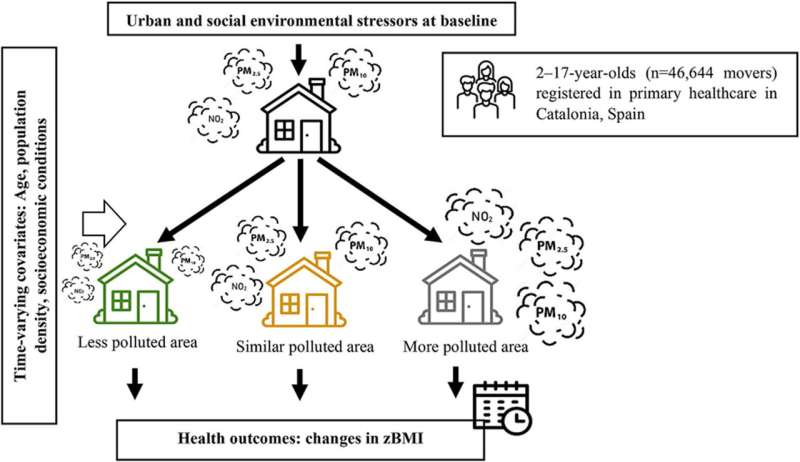This article has been reviewed according to Science X's editorial process and policies. Editors have highlighted the following attributes while ensuring the content's credibility:
fact-checked
peer-reviewed publication
trusted source
proofread
A natural experiment provides evidence of link between air pollution and childhood obesity

A large natural experiment in Catalonia shows that moving to areas with higher levels of air pollution is associated with weight gain in young children. The study, led by the Barcelona Institute for Global Health (ISGlobal), an institution supported by "la Caixa Foundation", in collaboration with the IDIAP Jordi Gol, provides further evidence to support efforts to reduce air pollution.
Overweight and obesity in childhood result from the interaction of genes, lifestyle behaviors, physiological and social factors. Environmental exposures such as air pollution may also play a role. However, it is not yet clear whether there is an association between air pollution and childhood obesity, and whether it is causal (i.e., whether air pollution directly causes obesity or overweight).
"A good way to investigate whether the two are linked is to see what happens when a child is suddenly exposed to higher or lower levels of air pollution as a result of moving to a different home address," says Martine Vrijheid, head of the Childhood and Environment research group at ISGlobal. "This is what we call a natural experiment."
In this study, a team led by Vrijheid took advantage of this natural experiment study design to assess whether changes in air pollution exposure due to residential relocation were associated with changes in body mass index (BMI). The study included 46,644 children and adolescents (aged 2 to 17) who moved once between 2011 and 2018 and were registered in the primary health care in Catalonia.
The research team estimated the annual levels of NO2, PM10 and PM2.5 particulate matter in each participant's home area, before and after moving. Weight and height were routinely measured at the primary care centers and were used to calculate BMI before and 180 days or more after the move.
Weight gain after moving to more air pollution
The analysis shows that moving to areas with more air pollution was associated with a small increase in BMI. This was true for all pollutants, and the effect was stronger in preschool- and primary school children. In contrast, moving to less polluted areas had no significant effect on BMI. "This may be because reductions in air pollution levels seem to be less relevant for those who were already exposed to high levels of pollution," says Sarah Warkentin, ISGlobal researcher and first author of the study.
Curiously, moving to areas with similar levels of air pollution was associated with decreases in BMI. "This could be because these areas are more walkable or have more play areas for children," says Warkentin. It could also simply be related to the stress of moving. Contrary to some studies in the US, the effect of air pollution on weight was independent of socioeconomic status.
The biological mechanisms that link air pollution to weight gain are not fully understood, but may include oxidative stress, inflammation of adipose tissue, reduced glucose uptake, hormonal disruption, changes in metabolism, or reduced lung function. More traffic may also lead to changes in behavior such as going less outdoors, which may result in an increase in weight.
Since the study relied on available data registered in primary health care centers in Catalonia, the researchers were not able to include these behavioral changes in their analysis.
"However, the data collected routinely by primary health care professionals allowed us to perform a very large natural experiment in a very large number of children and adolescents. This type of study could be replicated in the future to study the impact of the environment on other health problems," says Talita Duarte-Salles, head of the "Real World Epidemiology" research group at IDIAP Jordi Gol.
"Our findings suggest that moving to areas with higher levels of air pollution can lead to weight gain in young children. They also provide further evidence for reducing air pollution levels, in addition to other community interventions, to prevent childhood obesity and overweight," says Vrijheid.
The authors point out that although the magnitude of the observed associations is small, the impact on global public health could be large, given that 56% of the world's population lives in urban, more polluted areas.
The research is published in the journal Environmental Pollution.
More information: Sarah Warkentin et al, Changes in air pollution exposure after residential relocation and body mass index in children and adolescents: A natural experiment study, Environmental Pollution (2023). DOI: 10.1016/j.envpol.2023.122217


















